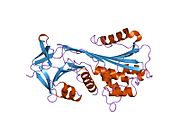From Wikipedia, the free encyclopedia
Alpha 1-antichymotrypsin (symbol α1 AC ,[ 5] A1AC , or a1ACT ) is an alpha globulin glycoprotein that is a member of the serpin superfamily. In humans, it is encoded by the SERPINA3 gene .
Function
Alpha 1-antichymotrypsin inhibits the activity of certain enzymes called proteases , such as cathepsin G that is found in neutrophils , and chymases found in mast cells , by cleaving them into a different shape or conformation . This activity protects some tissues, such as the lower respiratory tract , from damage caused by proteolytic enzymes.[ 6]
This protein is produced in the liver , and is an acute phase protein that is induced during inflammation .
Clinical significance
Deficiency of this protein has been associated with liver disease . Mutations have been identified in patients with Parkinson disease and chronic obstructive pulmonary disease .[ 7]
Alpha 1-antichymotrypsin is also associated with the pathogenesis of Alzheimer's disease as it enhances the formation of amyloid-fibrils in this disease.[ 6]
Interactions
Alpha 1-antichymotrypsin has been shown to interact with DNAJC1 .[ 8]
See also
Alpha-1 antitrypsin , another serpin that is analogous for protecting the body from excessive effects of its own inflammatory proteases
References
^ a b c GRCh38: Ensembl release 89: ENSG00000196136 – Ensembl , May 2017^ a b c GRCm38: Ensembl release 89: ENSMUSG00000058207 – Ensembl , May 2017^ "Human PubMed Reference:" . National Center for Biotechnology Information, U.S. National Library of Medicine .^ "Mouse PubMed Reference:" . National Center for Biotechnology Information, U.S. National Library of Medicine .^ Logan, Carolynn M.; Rice, M. Katherine (1987). Logan's Medical and Scientific Abbreviations J. B. Lippincott Company . p. 3 . ISBN 0-397-54589-4 ^ a b Kalsheker N (1996). "Alpha 1-antichymotrypsin". Int. J. Biochem. Cell Biol . 28 (9): 961–4. doi :10.1016/1357-2725(96)00032-5 . PMID 8930118 . ^ "Entrez Gene: SERPINA3 serpin peptidase inhibitor, clade A (alpha-1 antiproteinase, antitrypsin), member 3" .^ Kroczynska B, Evangelista CM, Samant SS, Elguindi EC, Blond SY (March 2004). "The SANT2 domain of the murine tumor cell DnaJ-like protein 1 human homologue interacts with alpha1-antichymotrypsin and kinetically interferes with its serpin inhibitory activity" . J. Biol. Chem . 279 (12): 11432–43. doi :10.1074/jbc.M310903200 . PMC 1553221 PMID 14668352 . {{cite journal }}: CS1 maint: unflagged free DOI (link )
Further reading
External links
PDB gallery
1as4 : CLEAVED ANTICHYMOTRYPSIN A349R
1qmn : ALPHA1-ANTICHYMOTRYPSIN SERPIN IN THE DELTA CONFORMATION (PARTIAL LOOP INSERTION)
2ach : CRYSTAL STRUCTURE OF CLEAVED HUMAN ALPHA1-ANTICHYMOTRYPSIN AT 2.7 ANGSTROMS RESOLUTION AND ITS COMPARISON WITH OTHER SERPINS
3caa : CLEAVED ANTICHYMOTRYPSIN A347R
4caa : CLEAVED ANTICHYMOTRYPSIN T345R











